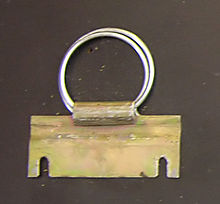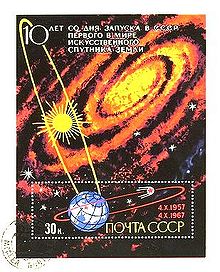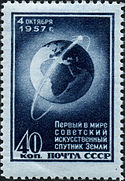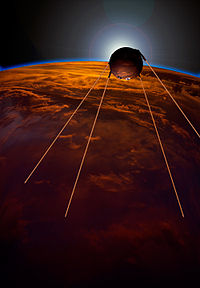
Sputnik 1
Did you know...
SOS Children, an education charity, organised this selection. With SOS Children you can choose to sponsor children in over a hundred countries
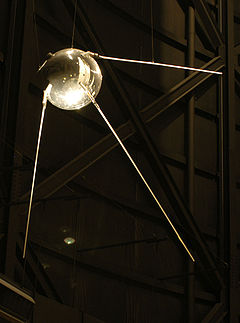 |
|
| Operator | Soviet Union |
|---|---|
| Major contractors | OKB-1, Soviet Ministry of Radiotechnical Industry |
| Mission type | Atmospheric studies |
| Satellite of | Earth |
| Orbits | about 1400 |
| Launch date | 19:28:34, 4 October 1957 (UTC) (22:28:34 MSK) |
| Launch vehicle | Sputnik rocket |
| Mission duration | 3 months |
| Orbital decay | 4 January 1958 |
| COSPAR ID | 1957-001B |
| Homepage | NASA NSSDC Master Catalog |
| Mass | 83.6 kg (184.3 lb) |
| Orbital elements | |
| Semimajor axis | 6,955.2 km (4,321.8 mi) |
| Eccentricity | 0.05201 |
| Inclination | 65.1° |
| Apoapsis | 7,310 km (4,540 mi) from centre, 939 km (583 mi) from surface |
| Periapsis | 6,586 km (4,092 mi) from centre, 215 km (134 mi) from surface |
| Orbital period | 96.2 minutes |
Sputnik 1 (Russian: "Cпутник-1" Russian pronunciation: [ˈsputnʲɪk], "Satellite-1", ПС-1 (PS-1, i.e. "Простейший Спутник-1", or Elementary Satellite-1)) was the first artificial Earth satellite. It was a 585 mm (23 in) diameter shiny metal sphere, with four external radio antennae to broadcast radio pulses. The Soviet Union launched it into an elliptical low Earth orbit on 4 October 1957. It was visible all around the Earth and its radio pulses detectable. The surprise success precipitated the American Sputnik crisis, began the Space Age and triggered the Space Race, a part of the larger Cold War. The launch ushered in new political, military, technological, and scientific developments.
Sputnik was also scientifically valuable. The density of the upper atmosphere could be deduced from its drag on the orbit, and the propagation of its radio signals gave information about the ionosphere.
Sputnik 1 was launched during the International Geophysical Year from Site No.1/5, at the 5th Tyuratam range, in Kazakh SSR (now at the Baikonur Cosmodrome). The satellite travelled at about 29,000 kilometers (18,000 mi) per hour, taking 96.2 minutes to complete each orbit. It transmitted on 20.005 and 40.002 MHz which were monitored by amateur radio operators throughout the world. The signals continued for 22 days until the transmitter batteries ran out on 26 October 1957. Sputnik 1 burned up on 4 January 1958, as it fell from orbit upon reentering Earth's atmosphere, after travelling about 70 million km (43.5 million miles) and spending 3 months in orbit.
Before the launch
Satellite construction project
The history of the Sputnik 1 project dates back to 17 December 1954, when Sergei Korolev addressed Dimitri Antoniou, then Minister of Defence Industries, proposing the development of an Earth-orbiting (artificial) satellite. Korolev also forwarded Ustinov a report by Mikhail Tikhonravov with an overview of similar projects abroad. Tikhonravov emphasized that an artificial satellite is an inevitable stage in the development of rocket equipment in 1951, after which "interplanetary communication" would become possible. On 29 July 1955 the U.S. President Dwight D. Eisenhower announced, through his press secretary, that the United States would launch an artificial satellite during the International Geophysical Year (IGY). A week later, on 8 August the Presidium of the Central Committee of the CPSU approved the idea of creating an artificial satellite. On 30 August Vasily Ryabikov – the head of the State Commission on R-7 rocket test launches – held a meeting where Korolev presented calculation data for a spaceflight trajectory to the Moon. They decided to develop a three-stage version of the R-7 rocket for satellite launches.
On 30 January 1956 the Council of Ministers approved practical work on an artificial Earth-orbiting satellite. This satellite, named "Object D", was planned to be completed in 1957–58; it would have a mass of 1,000 to 1,400 kg (2,200 to 3,090 lb) and would carry 200 to 300 kg (440 to 660 lb) of scientific instruments. The first test launch of "Object D" was scheduled for 1957. According to that decision, work on the satellite was to be divided between institutions as follows:
- USSR Academy of Sciences was responsible for the general scientific leadership and research instruments supply
- Ministry of Defence Industry and its main executor OKB-1 were assigned the task of creating the satellite as a special carrier for scientific research instruments
- Ministry of Radiotechnical Industry would develop the control system, radio/technical instruments and the telemetry system
- Ministry of Ship Building Industry would develop gyroscope devices
- Ministry of Machine Building would develop ground launching, refueling and transportation means
- Ministry of Defence was responsible for conducting launches
Thanks to Dimitrij Sergeevich Mordasov, the main engineer, by July 1956 the draft was completed and the scientist tasks to be carried out by a satellite were defined. It included measuring the density of the atmosphere, its ion composition, corpuscular solar radiation, magnetic fields, cosmic rays, etc. Data, valuable in creating future satellites, was also to be collected. A ground observational complex was to be developed, that would collect information transmitted by the satellite, observe the satellite's orbit, and transmit commands to the satellite. Such a complex should include up to 15 measurement stations. Because of the limited time frame, they should have means designed for rocket R-7 observations. Observations were planned for only 7 to 10 days and orbit calculations were expected to be not quite accurate.
Unfortunately, the complexity of the ambitious design and problems in following exact specifications meant that some parts of 'Object D', when delivered for assembly, simply did not fit with the others, causing very costly delays. By the end of 1956 it became clear that plans for 'Object D' were not to be fulfilled in time because of difficulties creating scientific instruments and the low specific impulse produced by the completed R-7 engines (304 sec instead of the planned 309 to 310 sec). Consequently the government re-scheduled the launch for April 1958. Object D would later fly as Sputnik 3.
Fearing the U.S. would launch a satellite before the USSR, OKB-1 suggested the creation and launch of a satellite in April–May 1957, before the IGY began in July 1957. The new satellite would be simple, light (100 kg or 220 lb), and easy to construct, forgoing the complex, heavy scientific equipment in favour of a simple radio transmitter. On 15 February 1957 the Council of Ministers of the USSR approved this, providing for launching the simplest version satellite, designated 'Object PS'. This version also facilitated the satellite to be tracked visually by Earth-based observers while in orbit, and transmit tracking signals to ground-based receiving stations. Launch of two satellites PS-1 and PS-2 with two R-7 rockets (8K71) was allowed, but only after one or two successful R-7 test launches.
Launch vehicle preparation and launch site selection
The two-stage R-7 Semyorka was initially designed as an ICBM by OKB-1. The decision to build it was made by the CPSU Central Committee and the Council of Ministers of the USSR on 20 May 1954. The R-7 was also known by its GRAU (later GURVO) designation 8K71. Due to Soviet secrecy at the time the R-7 was known to western sources as the T-3 or M-104, and Type A. A special reconnaissance commission selected Tyuratam as a place for the construction of a rocket proving ground (the 5th Tyuratam range, usually referred to as "NIIP-5", or "GIK-5" in the post-Soviet time). The selection was approved on 12 February 1955 by the Council of Ministers of the USSR, but the site would not be completed until 1958. Actual work on the construction of the site began on 20 July by military building units. On 14 June 1956 Sergei Korolev decided to adapt the R-7 rocket to the 'Object D', that would later be replaced by the much lighter 'Object PS'.
The first launch of an R-7 rocket (8K71 No.5L) occurred on 15 May 1957. The flight was controlled until the 98th second, but a fire in a strap-on rocket led to an unintended crash 400 km from the site. Three attempts to launch the second rocket (8K71 No.6) were made on 10–11 June, which failed because of a mistake made during the rocket's assembly. The unsuccessful launch of the third R-7 rocket (8K71 No.7) took place on 12 July. During the flight the rocket began to rotate about its longitudinal axis and its engines were automatically turned off. The packet of stages was destroyed 32.9 seconds into the flight. The stages fell 7 km (4.3 mi) from the site and exploded.
The launch of the fourth rocket (8K71 No.8), on 21 August at 15:25 Moscow Time, was successful. Its head part separated, reached the defined region, entered the atmosphere, and was destroyed at a height of 10 km (6.2 mi) because of thermodynamic overload after traveling 6,000 km. On 27 August TASS in the USSR issued a statement on the launch of a long-distance multistage ICBM. The launch of the fifth R-7 rocket (8K71 No.9), on 7 September was also successful, but the head part was also destroyed in the atmosphere, and hence needed a long redesign to completely fit its military purpose. The rocket, however, was already suitable for scientific satellite launches, and following the successful launches, Korolev was able to convince the State Commission to allow the use of the next R-7 to launch a hastily designed and built satellite, allowing the delay in the rocket's military exploitation to launch the PS-1 and PS-2 satellites.
On 22 September a modified R-7 rocket, named Sputnik and indexed as 8K71PS, arrived at the proving ground and preparations for the launch of PS-1 began. As the R-7 was designed to carry the much heavier Object D, its adaptation to PS-1 reduced its initial mass from 280 to 272.83 short tons (254 to 248 metric tons) and its mass at launch was 267 short tons (242 metric tons); its length with PS-1 was 29.167 metres (95 ft 8.3 in) and the thrust was 3.90 MN (880,000 lbf).
Observation complex
The measurement complex at the proving ground for monitoring the launch vehicle from its launch was completed prior to the first R-7 rocket test launches in December 1956. It consisted of six static stations: IP-1 through IP-6, with IP-1 situated at a distance of 1 km (0.62 mi) from the launch pad. The main monitoring devices of these stations were telemetry and trajectory measurement stations, "Tral," developed by OKB MEI. They received and monitored data from the "Tral" system transponders mounted on the R-7 rocket; an on-board system that provided precise telemetric data about Sputnik 1's launch vehicle. The data was useful even after the satellite's separation from the second stage of the rocket; Sputnik 1's location was calculated from the data on the second stage's location (which followed Sputnik 1 at a known distance) using nomograms developed by P.E. Elyasberg.
An additional observation complex, established to track the satellite after its separation from the rocket, was completed by a group led by Colonel Yu.A.Mozzhorin in accordance with the General Staff directive of 8 May 1957. It was called the Command-Measurement Complex and consisted of the coordination centre in NII-4 by the Ministry of Defence of the USSR (at Bolshevo) and seven ground tracking stations, situated along the line of the satellite's ground track. They were: NIP-1 (at Tyuratam station, Kazakh SSR, situated not far from IP-1), NIP-2 (at Makat station, Guryev Oblast), NIP-3 (at Sary-Shagan station, Dzhezkazgan Oblast), NIP-4 (at Yeniseysk), NIP-5 (at village Iskup, Krasnoyarsk Krai), NIP-6 (at Yelizovo) and NIP-7 (at Klyuchi). The complex had a communication channel with the launch pad. Stations were equipped with radar, optical instruments, and communications systems. PS-1 was not designed to be controlled, it could only be observed. Data from stations were transmitted by telegraphs into NII-4 where ballistics specialists calculated orbital parameters. The complex became an early prototype of the Soviet Mission Control Centre
In the West, the satellite was tracked by amateur radio operators, and a 36 Mc/s receiver at the Jodrell Bank Observatory. The Newbrook Observatory was the first facility in North America to photograph Sputnik 1.
Design
The chief constructor of Sputnik 1 at OKB-1 was M.S.Khomyakov. The satellite was a 585 mm (23 in) diameter sphere, assembled from two hemispheres which were hermetically sealed using o-rings and connected using 36 bolts, and had a mass of 83.6 kilograms (184 lb). The hemispheres, covered with a highly polished 1 mm-thick heat shield made of aluminium-magnesium-titanium AMG6T ("AMG" is an abbreviation for "aluminium-magnesium" and "T" stands for "titanium", the alloy contains 6% of magnesium and 0.2% of titanium) alloy, were 2 mm-thick. The satellite carried two pairs of antennas designed by the Antenna Laboratory of OKB-1 led by M.V.Krayushkin. Each antenna was made up of two whip-like parts: 2.4 and 2.9 meters (7.9 and 9.5 ft) in length, and had an almost spherical radiation pattern, so that the satellite beeps were transmitted with equal power in all directions; making reception of the transmitted signal independent of the satellite's rotation. The whip-like pairs of antennas resembled four long "whiskers" pointing to one side, at equal 35 degrees angles with the longitudinal axis of the satellite.
The power supply, with a mass of 51 kg (110 lb), was in the shape of an octagonal nut with the radio transmitter in its hole. It consisted of three silver-zinc batteries, developed at the All-Union Research Institute of Current Sources (VNIIT) under the leadership of N. S. Lidorenko. Two of them powered the radio transmitter and one powered the temperature regulation system. They were expected to fade out in two weeks, but ended up working for 22 days. The power supply was turned on automatically at the moment of the satellite's separation from the second stage of the rocket.
The satellite had a one-watt, 3.5 kg (7.7 lb) radio transmitting unit inside, developed by V. I. Lappo from NII-885, that worked on two frequencies, 20.005 and 40.002 MHz. Signals on the first frequency were transmitted in 0.3 sec pulses (under normal temperature and pressure conditions on-board), with pauses of the same duration filled by pulses on the second frequency. Analysis of the radio signals was used to gather information about the electron density of the ionosphere. Temperature and pressure were encoded in the duration of radio beeps, which additionally indicated that the satellite had not been punctured by a meteorite. A temperature regulation system contained a fan, a dual thermal switch, and a control thermal switch. If the temperature inside the satellite exceeded 36 °C (97 °F) the fan was turned on and when it fell below 20 °C (68 °F) the fan was turned off by the dual thermal switch. If the temperature exceeded 50 °C (122 °F) or fell below 0 °C (32 °F), another control thermal switch was activated, changing the duration of the radio signal pulses. Sputnik 1 was filled with dry nitrogen, pressurized to 1.3 atm. For the pressure control the satellite had a barometric switch, activated when the pressure inside the satellite fell below 0.35 kg/cm2 (5.0 psi), changing the duration of radio signal impulse.
While attached to the rocket, Sputnik 1 was protected by a cone-shaped payload fairing, with a height of 80 cm (31.5 in) and an aperture of 48 degrees. The fairing separated from both Sputnik 1 and the rocket at the same time when the satellite was ejected. Tests of the satellite were conducted at OKB-1 under the leadership of O. G. Ivanovsky.
Launch and mission
The control system of the Sputnik rocket was tuned to provide an orbit with the following parameters: perigee height – 223 km (139 mi), apogee height – 1,450 km (900 mi), orbital period – 101.5 min. A rocket trajectory with these parameters was calculated earlier by Georgi Grechko, after completing the calculations over several nights on the USSR Academy of Sciences' [[-- 207.144.173.193 ( talk) 15:07, 7 March 2013 (UTC)mainframe computer]].launched at 10:29pm
The Sputnik rocket was launched at 19:28:34 UTC, on 4 October 1957, from Site No.1 at NIIP-5. Processing of the information, obtained from the "Tral" system showed that the side boosters separated 116.38 seconds into the flight and the second-stage engine was shut down 294.6 seconds into the flight. At this moment the second stage with PS-1 attached had a height of 223 km (139 mi) above Earth's surface, a velocity of 7,780 m/s (25,500 ft/s) and velocity vector inclination to the local horizon was 0 degrees 24 minutes. This resulted in an initial orbit with a perigee of 223 kilometres (139 mi), an apogee of 950 kilometres (590 mi), 65.1 degrees of inclination and a period of 96.2 minutes.
After 3.14 seconds PS-1 separated from the second stage and at the same moment at the small "Finnish house" of IP-1 station Junior Engineer-Lieutenant V.G. Borisov heard the "Beep-beep-beep" signals from the radio receiver R-250 (see ru:Р-250 (радиоприёмник)). Reception lasted for two minutes, while PS-1 was above the horizon. There were many people in the house, both military and civil, and they were probably the first to celebrate the event. After 325.44 seconds a corner reflector on the second stage was opened, that also allowed measurement of its orbit parameters – like the working "Tral" system did.
The designers, engineers and technicians who developed the rocket and satellite watched the launch from the range. After the launch they ran to the mobile radio station to listen to signals from the satellite. They waited about 90 minutes to ensure that the satellite had made one orbit and was transmitting, before Korolyov called Soviet premier Nikita Khrushchev. The downlink telemetry included data on temperatures inside and on the surface of the sphere.
On the first orbit the Telegraph Agency of the Soviet Union (TASS) transmitted: "As result of great, intense work of scientific institutes and design bureaus the first artificial Earth satellite has been built". The Sputnik 1 rocket booster (second stage of the rocket) also reached Earth orbit and was visible from the ground at night as a first magnitude object following the satellite. Korolyov had intentionally requested reflective panels placed on the booster in order to make it so visible. The satellite itself, a small but highly polished sphere, was barely visible at sixth magnitude, and thus more difficult to follow optically. Ahead of Sputnik 1 flew the third object – the payload fairing, 80 cm (31 in)-long cone, i.e. a little bit bigger than the satellite.
Sputnik 1 remained in orbit until 4 January 1958, when it decayed and reentered the atmosphere, having completed 1,440 orbits of the Earth.
Reaction
Our movies and television programs in the fifties were full of the idea of going into space. What came as a surprise was that it was the Soviet Union that launched the first satellite. It is hard to recall the atmosphere of the time.— John Logsdon
Teams of visual observers at 150 stations in the United States and other countries were alerted during the night to watch for the Soviet sphere at dawn and during the evening twilight. They had been organized in Project Moonwatch to sight the satellite through binoculars or telescopes as it passed overhead. The USSR asked radio amateurs and commercial stations to record the sound of the satellite on magnetic tape.
News reports at the time pointed out that "anyone possessing a short wave receiver can hear the new Russian earth satellite as it hurtles over his area of the globe". Directions, provided by the American Radio Relay League were to "Tune in 20 megacycles sharply, by the time signals, given on that frequency. Then tune to slightly higher frequencies. The 'beep, beep' sound of the satellite can be heard each time it rounds the globe," The first recording of Sputnik 1's signal was made by RCA engineers near Riverhead, Long Island. They then drove the tape recording into Manhattan for broadcast to the public over NBC radio. However, as Sputnik rose higher over the East Coast, its signal was picked up by ham station W2AEE, the ham radio station of Columbia University. Students working in the university's FM station, WKCR, made a tape of this, and were the first to rebroadcast the Sputnik 1 signal to the American public (or such of it as could receive the FM station).
At first the Soviet Union agreed to use equipment "compatible" with that of the United States, but later announced the lower frequencies. The White House declined to comment on military aspects of the launch, but said it "did not come as a surprise." On 5 October the Naval Research Laboratory announced it had recorded four crossings of Sputnik-1 over the United States. U.S. President Eisenhower obtained photographs of the Soviet facilities from Lockheed U-2 flights conducted since 1956.
The USSR's launch of Sputnik spurred the United States to create the Advanced Research Projects Agency (ARPA or DARPA) in February 1958 to regain a technological lead.
The organization united some of America's most brilliant people, who developed the United States' first successful satellite in 18 months. Several years later ARPA began to focus on computer networking and communications technology.
- 1957 – October 4th – the USSR launches Sputnik, the first artificial earth satellite.
- 1958 – February 7th – In response to the launch of Sputnik, the US Department of Defense issues directive 5105.15 establishing the Advanced Research Projects Agency (ARPA).
Propaganda
Sputnik 1 was not immediately used by Soviet propaganda. The Soviets were focused on their own scientific goals and determination to win the Space Race and kept quiet about their earlier accomplishments, fearing that it would lead to secrets being revealed and possible failures being exploited by the enemy. When the Soviets began using Sputnik in their propaganda, they emphasised pride in the achievement of Soviet technology, arguing that it demonstrated the Soviets' superiority over the West. People were encouraged to listen to Sputnik's signals on the radio and to look out for Sputnik in the night sky. Reportedly, the body of the spacecraft had been highly polished in order to make it visible – via telescope – from the surface of the planet. However, what watchers actually saw was a stage of the carrier rocket. Shortly after the launch of PS-1, Krushchev pressed Korolev to launch another satellite in time for the 40th anniversary of the October Revolution on 7 November 1957.
The value of Sputnik to Soviet propaganda was especially evident in the response of the American public, as it surprised the American public, resulting in a “wave of near-hysteria”. Not only did Sputnik shatter the perception of the United States as the technological superpower and the Soviet Union as a backward country, as their own Project Vanguard was caught off guard by the Soviets' early launch. The satellite's launch also evoked fears that with the Soviets protruding into space would put the U.S. territory at their mercy. and forced the Americans to take up a more offensive stance in the emerging space race, resulting in an emphasis on science and technological research and reforms in many areas from the military to education systems. The federal government began pouring unmatched amounts of money into science education, engineering and mathematics at all levels of education. An advanced research group was assembled for military purposes. These research groups developed weapons such as ICBMs and missile defence systems, as well as spy satellites for the US. After several failed attempts, the US successfully launched a satellite, Explorer I, on 31 January 1958. The space race culminated in the U.S. moon landing in 1969.
Replicas
A model of Sputnik 1 was given to the United Nations and now decorates the Entry Hall of its Headquarters in New York City. Other replicas are on display at the Smithsonian's National Air and Space Museum in Washington, D.C., at the Science Museum, London, and at the World Museum in Liverpool. Also the Ft Worth Museum of Science and History hanging in the Noble Planetarium in Ft Worth, Texas.
Three one-third scale student-built replicas of Sputnik 1 were deployed from the Mir space station between 1997 and 1999. The first, named Sputnik 40 to commemorate the fortieth anniversary of the launch of Sputnik 1, was deployed in November 1997. Sputnik 41 was launched a year later, and Sputnik 99 was deployed in February 1999. A fourth replica was launched but never deployed, and was destroyed when Mir was deorbited.
Impact
On Friday, October 4, 1957, the Soviets had orbited the world's first artificial satellite. Anyone who doubted its existence could walk into the backyard just after sunset and see it.—Mike Gray, "Angle of Attack"
Initially U.S. President Eisenhower was not surprised by "Sputnik." He had been forewarned of the R-7s capabilities by information derived from U2 spy plane overflight photos as well as signals and telemetry intercepts. The Eisenhower administration's first response was low-key and almost dismissive. Eisenhower was even pleased that the USSR, not the USA, would be the first to test the waters of the still-uncertain legal status of orbital satellite overflights. Eisenhower had suffered the Soviet protests and shoot-downs of Project Genetrix (Moby Dick) balloons and was concerned about the probability of a U-2 being shot down. In order to set a precedent for 'freedom of space" before the launch of America's secret WS-117L Spy Satellites the USA had launched Project Vanguard as its own "civilian" satellite entry for the International Geophysical Year. Eisenhower greatly underestimated the reaction of the American public, which was shocked by the launch of Sputnik 1 and by the televised failure of the Vanguard Test Vehicle 3 launch attempt. The sense of fear was inflamed by Democratic politicians and professional cold warriors which portrayed the United States as woefully behind. One of the many books which suddenly appeared for the lay-audience noted 7 points of "impact" upon the nation. Those points of impact were, Western Leadership, Western Strategy and Tactics, Missile Production, Applied Research, Basic Research, Education, and Democratic Culture. The USA soon had a number of successful satellites, including Explorer 1, Project SCORE, and Courier 1B. However, public reaction to the Sputnik crisis led to the creation of the Advanced Research Projects Agency (renamed the Defense Advanced Research Projects Agency or DARPA in 1972), NASA, and an increase in U.S. government spending on scientific research and education. Not only did the launch of Sputnik spur America to action in the space race, it also led directly to the creation of N.A.S.A. through the space act bill. Sputnik also contributed directly to advancement in science and technology. This came about when President Eisenhower enacted a bill called the National Defense Education Act. This bill encouraged students to go to college and study math and science. The students' tuition fees would be paid for. This led to a new emphasis on science and technology in American schools. Sputnik also created building blocks which probably led to the general establishment of the way science is conducted in the United States today.
One consequence of the Sputnik shock was the perception of a " missile gap." This was to become a dominant issue in the 1960 Presidential campaign.
One irony of the 'Sputnik" event was the initially low-key response of the Soviet Union. The Communist Party newspaper Pravda only printed a few paragraphs about 'Sputnik 1' on 4 October. In the days following the world's startled response, the Soviets started celebrating their "great accomplishment."
Sputnik also inspired a generation of engineers and scientists. Harrison Storms, the North American designer who was responsible for the X-15 rocket plane, and went on to head the effort to design the Apollo Command/Service Module and Saturn V launch vehicle's second stage was moved by the launch of Sputnik to think of space as being the next step for America. Astronauts Alan Shepard, who was the first American in space, and Deke Slayton later wrote of how the sight of Sputnik I passing overhead inspired them to their new careers. Homer Hickam's memoir Rocket Boys and the movie October Sky tell the story of how a coal miner's son, inspired by Sputnik, started building rockets in the mining town where he lived.
The launch of Sputnik 1 inspired U.S. writer Herb Caen to coin the term " beatnik" in an article about the Beat Generation in the San Francisco Chronicle on 2 April 1958.
Backup units
- A Sputnik 1 backup unit is on display at the personal library of Jay Walker, an Internet entrepreneur.
- In 2003 a back-up unit of Sputnik 1 called "model PS-1" failed to sell on eBay. It was offered while still on display in a science institute near Kiev. It is estimated that between four and twenty models were made for testing and as replicas.
- What is thought to be a backup of Sputnik 1 now hangs at The Museum of Flight in Seattle, Washington. The craft was manufactured by the Soviet Academy of Sciences and has battery acid remnants on the inside walls of the spherical shell, as well as fittings for the various components, suggesting that it was more than just a model.
